
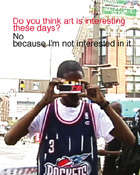
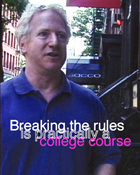

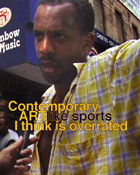
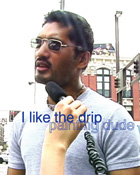
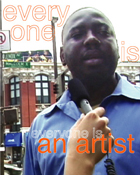
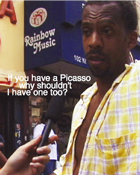
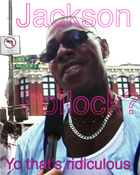

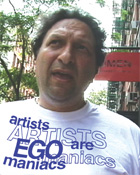
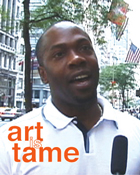

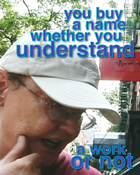
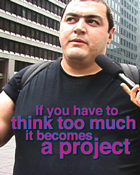
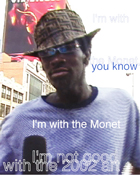
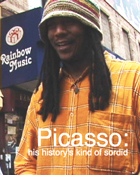

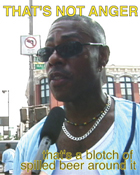
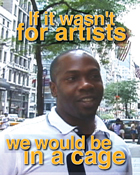
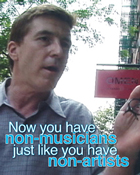
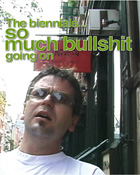

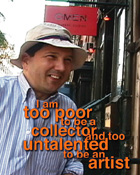
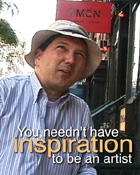

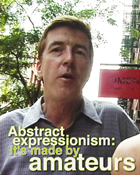
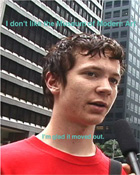
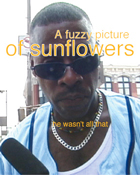
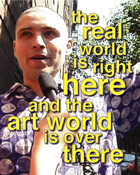
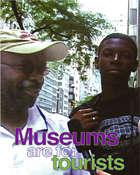

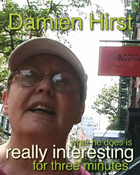
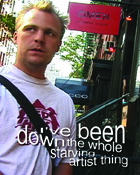
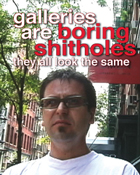
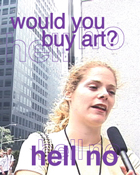
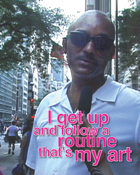
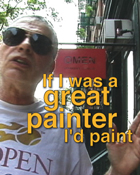

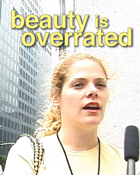
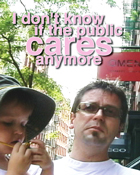
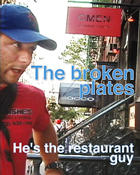

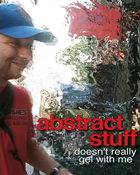
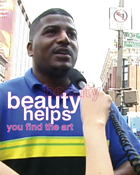
JASPER WHO?
Kenny Schachter interviewed by Elizabeth Bard
New York, July 2003
What led you to this project?
Whenever I lecture to university students, in an effort to prove how alienated and esoteric the art world is, I always state that if you interviewed 100 people on the street and asked them if they were familiar with Matthew Barney probably .001 % would recognise the name. So, I finally decided to test my theory and actually conduct the interviews myself. Guess what? I found out I was exactly right.
In 1949, Jackson Pollock was front-page news. The cover of Life magazine showed a crouching Pollock, paint dripping, cigarette dangling - with the headline: "JACKSON POLLOCK- Is He The Greatest Living Painter in the United States?". Pollock was America's first "art star", yet it seems that contemporary art has been falling further and further out of the consciousness of the general public. I'm not saying that the collective populous ever uniformly cherished art, but it was part of the discourse and the public imagination in a way that has faded significantly. Why?
Who is responsible for that? The art? The artists? The art world?
Everyone in the professional art world bears some responsibility - the dealers who make going to galleries such an inhospitable, sterile experience; the artists whose only aim in life is to climb the ladder to a better gallery, collections and museums (and social status); and the critics who write in an unintelligible language that communicates nothing more than the breadth of their vocabulary.
We are at a historical high, more people making, looking, but the business of art is closed to the general public. Art has become a specialty niche marketplace which embraces it's own rather than cultivating new audiences. But art can't exist without an audience. The art world has painted itself into a corner. They have tried so hard to limit their audience to the people who have money to buy - It's cutting the public off at the knees.
So see just how far contemporary art has drifted from our general consciousness, during the summer of 2002 I conducted this non-scientific survey featuring on-the-street interviews with more than 100 randomly selected individuals in Manhattan neighborhoods from Wall Street to Harlem. The intent was to subjectively gauge general perceptions of the relevance of contemporary art to the everyday lives of a cross-section of people. Questions were posed to take the pulse of how people felt about galleries, museums, technology in art, and notions of beauty, among others. Additionally, when there was some level of familiarity with art and artists among interview subjects, a laundry list was read containing names from Picasso to Matthew Barney to get a glimpse of how well the art world communicates its most talented ranks across social boundaries.
Is this drift, this scepticism, universal - or an American thing?
European countries, England and Germany, for example, have a very different attitude when it comes to recognition and awareness of contemporary artists. Tracey Emin, Damien Hirst and other members of the still percolating YBA movement are A list celebrities. Just about every cab driver knows something about either the art or the antics - Emin, drunk, nearly puking on live TV or Hirst's filleted animals. The fodder for the tabloids has culminated in advertising campaigns featuring Emin posing in Viviane Westwood and even peddling booze - I doubt this cynical angle would float in puritanical America. Hirst's signature vitrines are aped in all sorts of media from political cartoons to insurance adverts. Only in a society where the contemporary art is known to the general public can it be parodied in this way.
In Germany, many may doubt the artistic merit of a pile of fat casually clumped in the corner of a room, but the majority know a Joseph Bueys when they see one. Furthermore, it is not uncommon to see one of his unlimited editions in the home of a middle class family with no art contacts. Not since Andy Warhol did a cameo appearance on "The Love Boat" has an American artist neared that level of notoriety.
European mass media is paying attention as well. In any given year, the UK's 5 measly TV stations boast more contemporary arts programming than the past 5 years in the US. There have been countless UK documentaries on artists of all stripes, and many instances where artists have been commissioned to create original segments for TV. The US equivalent is sceptical segment on 60 Minutes, "Yes, But is it Art" - where a busload of kids are confronted with a Basquiat painting and queried as to whether they could do a better job.
Critic Robert Hughes had a Public Broadcasting Network special a number of year's back where he expounded upon how initials scratched into a tree were more artistic than contemporary art. Some prescient choice to helm the curator's post for the upcoming Venice Biennial - shame he withdrew. Of late in the US, there was the monotonous thematic show entitled Egg, which touched on art from time to time and was in turn cancelled. Art 21 profiled a group of contemporary artists last year, over the course of four episodes. Though the reported audience totalled 2 million for the entire broadcast, and more were ordered, the show stuck to an unprogressive, uninspired format that lacked even rudimental entertainment value. Financing has yet to be locked into place for a continuation of the series.
What came out of your search?
The fantastic, eye-opening revelation that art effects, and impacts more people than I ever could have envisioned. People's definitions of art were expansive, but it was truly integral to the every day existence of a majority of the individuals queried - individuals from all walks of life.
It was a strange mix - gone are the days of Picasso or Abstract Expressionism where an artist or movement held sway in the imagination of the general pubic, yet art was prominent in the minds of many as a personalized inward notion of creativity. Contemporary art was judged a specialized professional niche akin to the study of nuclear physics or artificial intelligence. But under the broad category of artistic expression the interviewees named a wide of variety of activities - cutting hair, rap, architecture, the way a person walks across the street - that is, everything but contemporary art itself.
Why do people seem to feel so alienated by contemporary art, and, it seems, the system that promotes it?
What makes people so suspect of the art world is the pseudo-erudite mindset, the feigned universe of scarcity and exclusivity that is alluded to by all. It is designed to promote the idea that art can only be understood by the few, and afforded by even fewer. Something for the hyper wealthy and specifically NOT for the mainstream.
Another reason sited for the disinclination towards new art forms – aside from mirroring present day political and social woes that no one wants to face – was the consensus that they are lacking a traditional sense of skill, technique and human touch involved in the processes. This was especially true in the realms of computer and video art which were seen as not just a short cut, but akin to cheating. Another telling comment was contemporary art as "images of images of images", thus a removal, or distancing of art production from primary experience or traditional notions of beauty. Most were unaware of the derision the Impressionists encountered - for just this reason - when first exhibiting their paintings, versus the universal admiration and blockbuster status they are met with now, where "Target stores have all the Van Gogh prints!"
Are people angry, bewildered, or just bored?
All the above.
I think there has been a backlash to art viewed as shocking - call it "The Sensation Syndrome" after the Saatchi exhibit at the Brooklyn Museum in 1999, which inured people from being affected by art judged offensive. Today there is a weariness, numbness, and level of familiarity with art meant to affront. It is regarded as almost academic. In the words of one interviewee "Breaking the rules is practically a college course".
What is the public's perception of artists? Of the art world?
There was a clear scepticism - comments that contemporary art was an inside joke and "a racket", and not of the Richard Prince variety. The only idea about geometry in art shared by all the interview subjects was the perception that a clear line delineates the real world from the art world – they are distinct spheres where there is no crossover, only mutual alienation. Characterizations ranging from soulless, to fraud, to being too cerebral-all were geared towards rationalizing a dismissal of new art. Artist's too were accused of failing to make an effort to connect with the rest of society. As put forth by one: "Artists live in a post-modern dreamy dreamy world."
And of the art itself?
"Now its greed it's just making money, it's become big business like everything else. You buy a name". Art is seen as part of the Prada parade and artists are nothing more then brand names. People buy into trends or fashion whether or not there is a full comprehension of the significance of the artwork at hand. "It's about buying and owning rather than appreciating beauty."
What about museums?
There was a feeling that art is part of the patrimony of the country, something not to be profited from and something at everyone's disposal. The majority of participants didn't consider art strictly for the wealthy; rather, what turned people off was the content of the art itself ("New art is like, you know, Coors Light") and the environments where it is presented. There was a shared antipathy relating to the art going experience. Galleries and museums were widely viewed as clinical, sterile, and elitist - all adjectives of intimidation: "I don't like it when they follow you around everywhere and they don't want you to touch anything."
Have flashy architecture and blockbuster exhibitions helped?
Blockbuster exhibitions are fine and dandy, but we really need to imagine beyond yet another rendition of Impressionism, or another match-up between Picasso and Matisse. Enough. Flashy new museums are wonderful - it seems we are discovering architecture for the first time in a very long while - its what goes on inside those new buildings that could use some help. Someone please help.
Despite the popular appeal of architecture brought about by the Guggenheim phenomenon ("I've been to a couple of Guggenheims in Europe") there is a tedium in the sameness of gallery interiors the world over and a sense that they were designed for a rarified public: "People who go there are predominantly people who are interested in art anyway." The cold glances of gallery and museum staff were seen as palpable browbeating: "You feel a pressure to look a certain way." In the end, commercial galleries would better serve the public by chipping away at barriers, rather than erecting them. "I think the biggest hurdle is to get people to go to the galleries who don't necessarily go to begin with."
Is there any common belief that all the interviewee's seemed to express about art?
People love art, love making things, love taking a creative approach to life's everyday problems and issues. Art has a democratic definition more expansive I - or the art world -could ever have conceived. It is this openness that must be embraced rather than shied away from or shunned.
Beauty was also an integral component of art in the minds of many - but the definition cast a wide net, way beyond "a pretty picture". Beauty being in the eye of the beholder, an oft-repeated cliché, seemed to indicate an accepting, liberal conception of how subjective taste can be.
People were sceptical about access to the art world for the common man. "I'm too poor to be a collector and too untalented to be an artist". - and even more sceptical about the art itself - "I could spread myself with peanut butter and play around Washington Square Park and call it art". On acclaimed Brit bad boy, Damien Hirst: "What he does is interesting for three minutes." One easy step to art - "you can turn it into art if you frame it." On the prevalence of the internet and computers now ubiquitous in biennials and galleries: "Computers are good for tracking locust infestations in the third world. A computer found a computer for my son when he needed it four years ago." Take that, Whitney Bitstreams.
Are people aware of the history of art?
Whether people are aware of the history of art is not really an issue (I had no idea when I started professionally, being wholly self-taught); it is certainly not intrinsic to being exposed to, absorbing, and enjoying looking at art. What is interesting is how poorly and ineffectually the art world has communicated its leading lights as opposed to stars of yesteryear like Picasso and Warhol.
When faced with a laundry list of artists there seemed to be a universal awareness of Picasso and Warhol ("He's done wonders for advertising"). Less than a handful of people recognized the names of artists like John Currin, Janine Antoni and Cecily Brown. Matthew Barney, perhaps the most acclaimed American artist of his generation, got no more that three or four nods - not surprising given his and his dealer's reluctance to seek wide dissemination of his art and films (prior to his recent retrospective). As Matthew Barney said in a New York Times Magazine article by Michael Kimmelman (October 10, 1999) entitled The Importance of Matthew Barney: "If a work is shown too many times, something gets stolen from it. You come to it with preconceptions, or you get tired of it. And it's the same with an artist. So I try to protect myself and my work." The result of this protectionist attitude is that he is not only an enigma, but also one that remains unknown to most. One interviewee summed it up: "Uh, I know Barney's the store."
What's the solution?
The solution is for people in the art trenches to reach beyond an audience of a small handful that they continually perform for. The art world must decide for itself to communicate beyond the established universe of known collectors, critics, dealers, curators, etc. It takes a dose of forward thinking to cultivate new audiences, a slow tedious process of nurturing relations. We must look past the same shows in the same venues with the same artists. Go beyond the tired international biennial circuits with the predictable international cliques of stars that repeats itself ad infinitum.
Thankfully, in spite of mild to medium malaise for ultra contemporary art, I found a shared open-mindedness pertaining to art broadly defined, across a wide spectrum of communities. We are on the threshold of an unparalleled opportunity to expand upon art appreciation and acceptance internationally. Examples in the museum world shed light on how the entrepreneurial sector (i.e. galleries) can seize back the initiative to turn the table on contemporary art phobia. One positive new effort was the Guggenheim in Las Vegas – I imagine it would have opened a few unsuspecting eyes to the merit of looking at newer art had 9/11 not put an abrupt halt to the experiment. Another is the Palais des Tokyo in Paris, a fresh, raw, unorthodox space with the atmosphere and hours of a bar or nightclub but filled with challenging and fresh new art production. If the private galleries followed suit, we could be on the verge of an unbounded rise in contemporary art acceptance and patronage.
EXCERPTS FROM HARLEM INTERVIEWS
MALE, AFRICAN AMERICAN, THIRTIES (Pg. 37)
Q. Does art have any relevance in your life?
A. Art? What kind of art?
Q. Any kind.
A. Yes, it does.
Q. In what ways?
A. Well, everything I look at is art. It's all around me. And basically if we don't have a good representation of art, then we can be misled. False advertising. These signs that provocate things that's not true. As far as like kids wearing Rolex watches. And if you look at some of these signs. It's making people do things quite naturally that… you know… they're not - I don't know what I'm trying to say. The point I'm trying to make is that the more things that we look outside at, the more things we try to assimilate with and associate with. But if we were to get some positive things up, we would be in a more positive direction with some of our lives. Especially young people. They are misled. Gold change. Everyone wants to be a big shot, big car. I don't think those things are helping us, you know. Art and one can help us redirect that energy into something more constructive.
Q. Have you been to a gallery or museum recently?
A. Yeah I've been to some museums. I've been to Guggenheim. Me and my daughter, we went to Natural History. We've been to a few-
Q. Did you enjoy the experience?
A. Yeah. Because not only do they hold things that are not here in the present anymore, that came from the past, but it also gives us insight on what we can do for tomorrow.
Q. And what did you think of artists?
A. I think we're all artists. But we have to form that – I mean, we have to build on that creativity. We're all artists in our own way.
Q. And what's the last piece of art that you've seen that's made an impact on you?
A. Mmm… That's a hard question. Because I've seen so many pieces of art work. But just of recently. They did a mural here – a little mural here on Madison and Fifth Avenue, on the wall. It's not no real like exquisite art or anything but it has a good message. Like I was saying, it's a positive message. It's like a lot of kids drawing, paintings of kids and stuff on the wall. But there's little signs that say "Don't do drugs." "Don't smoke." Yeah. So that's the type of things I'm saying about art. If we use those things and we give information out and inform people on what they can do to better themselves then we can be a better race of people. All of us.
Q. And do you think art is available for everyone or more accessible for the wealthy?
A. Well, in one aspect it's more accessible to the wealthy. And on the other aspect, it's available for everybody because art is something you can do on your own. But, to be successful with art, I would think you would have to be from a wealthy background or be around wealthy people that would want to, you know, condone whatever it is your doing. Because some people that are artists out here it's got a bunch of bullshit, excuse my French. This abstract - they think – they put up on Sotheby's or they sell somewhere and get millions of dollars for it. Now if an African man comes out and he carves a little piece of man out of a piece wood. And you look at it and say, "Hey, that's nothing but a piece of wood."
Q. So, the contemporary art that you're talking about. You don't like it?
A. I like it but like anything else, like sports and basketball, I think it's overrated. I think number one, if someone produces a piece of art – if someone were to produce a piece of art and it would have to be to the liking of someone else that might want to purchase it. It could be anything. It could be a boxing glove or a pair or boots. But like I was saying, I don't think art is something to make a profit off from. It should be at everyone's disposal. Maybe if you have a Picasso why shouldn't I have one too. Or Renoir. Or whatever. I want one too.
MALE, LATINO, TWENTIES (Pg. 46)
Q. Does art have any relevance for you?
A. Um, sure. I go to college. I just getting out of work. Basically art is um.. how can I say it? It's very historical, you know. Art being in American – no not America worldwide since hundred years ago and I think um…
Q. And are you an artist.
A. No, but I got a lot of amigos – I've got a lot of friends and they paint, they make sculptures.
Q. And if you were an artist, what kind of art would you do?
A. I like sculpture. Like creating kind of figures. Like women, females.
Q. Do you go to museums and galleries regularly?
A. Well I go sometimes Natural Historical Museum on 86th street. I go to Metropolitan one. I don't very - go like um… a couple… like twice a month or once.
Q. And what do you think of the experience? Do you like going to museums?
A. Yeah, sure. It's kind of fun, you know. You do a lot of things. You see a lot of things basically that we don't have a chance to see. It's very fun, you know?
Q. I'm going to list for you a group of artists and can you list for me what you think of their works.
A. Are these painters?
Q. Mostly.
A. Okay.
Q. Pablo Picasso?
A. Yeah, he's an Italian – um Italian painter. He did the Mona Lisa right?
Q. No.
A. That's Michaelangelo right? Michaelangelo did the Mona Lisa, right?
Q. Da Vinci.
A. Yeah, DaVinci.
Q. What about Andy Warhol?
A. I've never heard of him.
Q. What about Jackson Pollack?
A. I've never heard of him.
Q. And what kind of work do you like?
A. Um… what kind of – I don't understand that?
Q. What kind of art?
A. In general? I like painting.
Q. What's the last piece of art that you've seen that made an impact on you?
A. Gee. Oh, last Sunday. I went to the see to The Natural Historical Museum. And I saw the painter, nineteen - eighteen hundred, by a European guy. I'm not really sure. And it was about sculpture, it was about everything – his clothing, his jewelry, his face... They got a series… Back then they drew a lot of king people, a lot of noble people, warriors. Basically… This guy, the guy I saw in the picture, he was very straightforward. Very formal. Very straight. It was kind of interesting.
EXCERPTS FROM MIDTOWN INTERVIEWS
MALE, AFRICAN AMERICAN, LATE TWENTIES (Pg. 59)
Q. Does art have any relevance in your life?
A. Yeah. I'm a very visual – I actually do the windows for Kenneth Cole. Art is my life.
Q. And as an artist. You do consider yourself an artist?
A. Yeah. I am an artist with space. So I can do interior design, I can do stage, I can do windows. I can do a lot of things. I think creative people, artists - you're born that way and any medium that you put into you can do it.
Q. How do you respond to the criticism that anyone can do art.
A. I don't think anyone can be an artist. I think certain people are born to do certain things. Like there are people who are supposed to be basketball players. They're just genetically made for that. I think artists, we think a certain way. We think in uh an alternative lifestyle. We really do not try to fit in. we try to but there is something in our nature that separates us from the rest of society. There's a small amount of artist, but we control everything you see, how the world is. If it wasn't for artists, humans could still be animals, we could still be, you know, in a cage somewhere. But creative people made society what it is.
Q. And how important is beauty in art?
A. Um, it's just as important as the dark side – the ugly. I explore it all. I think that's the one thing I love being African American in, in art. I can experience a whole spectrum. I can be Fifth Avenue – Fifth Avenue Seventeenth street or Fifth Avenue Sixtieth street in one day. You can go to the Whitney and I can go down to the Bowery; I can see beauty or … to me there is no such thing as ugly.
Q. Have you been been to the gallery or museum recently?
A. Yeah
Q. What do you think about that experience?
A. It's not like it used to be, here in New York. There was a time in the 80s in New York where art was everywhere. Creative people just explode. Art is tamed now. There's more control now.
Q. Why?
A. Money. With a capitalist society, our whole concept of living, our existence in the United States is to make money. To make money you have to have control so in order to make money from art from art, it has to be under control.
Q. Do you think art is only for the wealthy?
A. No. No. Art is for everyone that wants to appreciate it. And it depends on what you, what the individual considers art. And even that definition doesn't define what it really is. It can be a movement. It can be a movement in someone's… the way a lady moves across the street can be an art form, because she's very elegant. You know art can be a new phone, or an old phone that we don't use anymore and you put it inside a museum, you put it on a pedestal and it becomes art. It really is in the mind of the individual that is looking at it.
FEMALE, WHITE, THIRTIES (Pg. 75)
Q. Does art have any relevance in your life?
A. Every relevance in the world. I think it's the end all and be all of everybody. To me, art is the most important thing to wake up to in the morning and I have it surrounding my house. And I'm very involved with it, with my child. He loves art himself.
Q. So do you buy art?
A. Yes I do.
Q. How do you buy art? Through what means?
A. Just – I buy whatever I like. I don't really have a particular gallery that I go to. I have things from Louis Shalon (?) to Erte that are totally different and all unique it their own way. Same thing like the Andy Warhol soup can shopping bag, as a difference. To show you the different in art I like. I just buy what I like.
Q. Is beauty important in art?
A. I think, but then again it's in the eyes of the beholder. And I think that basically everybody sees beauty in a different way. So, I think it's individual.
Q. Do you consider yourself an artist?
A. Yes I do.
Q. Can you describe the art that's important in your life?
A. Well, I'm a fashion designer but I've also done work for Disney and Warner Brothers and these hand beaded sequined cartoon jacket which are actually signed and numbers in some of the stores.
Q. Do you go to the galleries and museums in New York?
A. Yes I do.
Q. And what do you think of the experience?
A. I think it's amazing. I don't think that there's anywhere in the world that I've been to that is as enriching as the museums in New York City.
Q. I'm just going to list a group of artists. Can you tell me what you think of their work? Pablo Picasso?
A. I think it's very inter- fabulous. Interesting. Wonderful.
Q. Andy Warhol?
A. Yes. Love Andy Warhol. That's another unique way of taking different kinds of medium and using it to create art in a different way that wasn't understandable at one point but now it's so valuable.
Q. Jackson Pollack?
A. Love Jackson Pollack. Love. Love. I love his use of color. Just incredible.
Q. And what do you think of Contemporary artists these days?
A. Um, I think a lot of them are doing, you know, sort of copies of what was in a different sort of manner. I think art lives from the past to the present and I can see details in the contemporary art that is very much from the past.
Q. Are you familiar with any of their names – Tracey Emin, Matthew Barney, John Currin?
A. No.
Q. And what's the last art that you've seen that made an impact on you?
A. Actually, the gentleman across, outside F.A. O Schwartz. A Chinese gentleman actually was drawing the names on a piece of paper, you know, with the frame around the border. It really really - his use of colors. And his technique of using images to create names was fabulous. And I now they do it several places around here but I've never seen anyone as good as him. Actually, outside Toys R Us.
EXCERPTS FROM SOHO INTERVIEWS
MALE, WHITE, FIFTIES (Pg. 85)
Q. Does art have any relevance for you?
A. Yes.
Q. Why?
A. It enriches your life. If it's of any value. Something that… It's important. It's like music it's like literature. It's important.
Q. What's the last piece of art that you've seen that made an impact on you?
A. You mean literally last piece I've seen that's significant?
Q. Am I ever going to know that you're not telling me the truth?
A. I saw a Francis Bacon painting a couple of months ago around the corner that was a beautiful painting in real life. I've only seen it in reproductions. A triptych of his last lover, or second to last lover.
Q. What about it?
A. It just has a composition. The size of the work, the composition, the flesh tones, the distortion of the image, his whole set of, uh, techniques. It just came together in those three triptychs. And it was powerful. That's the last thing I saw that I stood in front of and… I react to his work because he deals in – eh – figuratively. Representational aspects of the human figure. It's not purely abstract work.
Q. Do you go to museums and galleries?
A. No I don't go to galleries but I do go to museums regularly.
Q. Why? What's the distinction?
A. Because contemporary art is what they show in galleries and contemporary art, for the most part, is awful.
Q. Why?
A. It's soulless, it's as soulless as the music is. It's been going downhill since the 1940's.
Q. Why did it go down?
A. Because. Because it was taken out of the hands of the Europeans and synthetically - the center of art was moved to New York City. Probably because of the war as much as anything else. And they suddenly told people that abstract expressionism was where art was going. Where abstract art was where everything was going. Figurative painting was dead. Representation painting was dead. The surrealists were the last thing of interest. I think Abstract Expressionism is a fraud. I think that people who practice it are not – are certain people who – you rarely find someone who is able to do something in art that is – in art. To draw, to render, to paint anything else who because an abstract expressionism. It was the last resort of people who didn't have the skill to be any other kind of painter. Abstract Expressionism is like the punk rock of the art world. It's made by amateurs -
Q. So you hate punk rock too?
A. No I don't hate it. It's a natural – it's a natural, adolescent urge. I mean, to want to make a lot of noise with an instrument without any training, without any background. Without knowing the rules of music, and thinking you can break them without knowing them. Abstract expressionism, well – Picasso had already done it. Braque had done it with, um – cubism. They knew how to do everything they had to – they can do everything then they deconstructed it. If you ever saw the work of Jackson Pollack before his moment of glory around 1949-1950. About two years when he did those drip paintings, he was awful. He was absolutely dreadful. In his thirties, when he worked for Thomas Hart Penton, they didn't even want him as a student. He was such a poor draftsman. You have people like Barnett Newman who became stars who just had a retrospective. Barnett Newman – not even his friends who were painters thought he was any good until 1960 when they ran out of the all the other Abstract Expressionist. They're like, "Oh, there's Barnett Newman. We haven't put him on the cover of Time Magazine yet. Let's make him – eh…" He didn't know how to paint. I knew people who knew him. I know a ninety-year-old painter who knew him back then. He didn't know how to paint. Neither did – the other bloke – Mark Rothko. I mean they just sort like … It was just what was going on at the times.
Q. And who makes these people into -
A. There's probably three hundred people in the world who decide who's going to be the next big artist and who's going to – Peggy Guggenheim made Jackson Pollack. If you asked a hundred people in the United States in 1955 you showed them a Jackson Pollack and anyone, any representational painter, Thomas Eakins, or Thomas Moran, or Vermeer or anyone else which was a more meaningful painting – no one would choose Jackson Pollack. No one would choose Abstract Expressionism. Blocks of colors on canvas. I mean, it's just more about ideas. It's theories more than a … and that just accelerated into the sixties. Into – you have Pop art. You have someone like Andy Warhol, who came into it as a joke. An inside joke. I mean, to make these cans, he wasn't trying to make an artistic statement. It was a comment on other people doing the same thing. What was going on at the time. And the same art community that catapulted guys like Pollack, De Kooning and Jasper Johns, this was before Jasper Johns. Pollock, De Kooning, Motherwell and that crowd to the Parthenon of art priests. High priests of art. The same people who made Andy Warhol this darling of the seventies. He took Polaroid's and charges fifty thousand dollars for it. They thought they were hip because they were paying the clown. He was laughing his way all the to the bank. It was a joke. It was meant as a joke. People don't get it. They thought it was for real. That's what they've been following. Same thing is happening with popular music. The golden age of American songwriting is probably 1925 and 1955 and maybe 1960, in terms of music, in terms of jazz.
Q. You're cutting the Beatles out completely.
A. I'm saying they were the beginning of the end of the period. That's just one group, that's not all music. By the late sixties things were fractured and the corporations came in and told people what they were going to listen to. And electronics came in and technology came in and that's why for the last twenty five years pop music has been worst than anyone's every heard. You have the golden period in music. At that time, the twenties, the thirties, the forties, the fifties – people knew how to write music. People knew how to write melodies. They knew how to arrange groups of musicians. They knew how to play music – they were musicians. Now you have non-musicians, just like you have non-artists – what I consider… I don't consider people who do conceptual art, people who do abstract art artists really. I think having artistic aspirations and being an artist are two different things
Q. And do you see any change?
A. No, I don't see it getting anything but worse. I don't see it getting anything but worse. It's going to get more mechanical, more mass -produced. Just like music. You have two generations of kids who've never picked up an instrument and don't know what music is. Who think that the best music being made is the stuff made yesterday. And the same thing with art. You go around to Chelsea and into all these galleries and in and out. It's bland soulless meaningless stuff. It's images based on images based on images. It's like a Quentin Tarantino movie. It's not a movie about people, it's a movie about movie images and people. It's cannibalizing other movies to make a movie. "Wow, that's original." It's not original. It's just a pastiche of other people's – of people who actually did care about the characters. Who actually did have empathize with man. Because the scripts were written by people who wrote and who knew what stories were about. Films today aren't written today by people who know stories, who knows anything about human characters. They're writing about images. They're writing about film techniques. The technology advances but the sensitivity, the insightfulness of the artist isn't getting any better. But they actually have less introspection, they have less… It's easy to take a photograph, and manipulate a photograph. You look at the work today, the artists work today. A lot of it is based on digital photography. They take digital photographs, they make transparencies, they project it , they print it on the printer, they project the printer on a canvas and they paint that. And the ones that have some skill as a draftsman will print it onto a card, on a canvas and will copy it. But the image is photo generated and it's not – and it appears to be photo-generated And that's the point. Just like the music today. You hear a drummer, it's a drum machine. It doesn't have a tone to it. It doesn't have any personality. "Well, that's what it's supposed to be, that's what the people want to listen to." They want to hear dub beat, as they refer to it. They don't want to listen to a drummer, who knows what he's doing, someone who knows – who's subtle and inventive and can turn it on the dime. They don't want that. They want someone to press a button and turn on a machine. They don't want singers, they want people who rap, you know. Which is something you can stand next to any street corner in any neighborhood talking about what a big deal they are. It's just that the whole – the culture has become… technology has advanced and people just happened. Just because you have a digital camera doesn't mean you're a great photographer just because you can take better picture than your father on his brownie camera on a Sunday afternoon during a family outing. But if you look at those pictures, some of them look a whole lot better than the new Gerhard Richter or the new – whoever doing painting. There was a painter in the seventies, David Salle. I guess is how you pronounced his name. The stiff he did is the stuff they're doing now. It's just images; it's dead. It's just images. And it came out of the whole Warhol thing, out of the whole Pop thing. It's almost like – It's almost like… you have the forties and fifties and they told you image was dead. Representation was dead. Flatness was everything. That the… The whole, if you read the whole nonsense about abstract Expressionism except they've written more about it. They have to write it. They have to explain what it is because people… You go to the Reinhert show, you walk through the gallery – I see sixty black paintings. Then I hear the gradations in black, it's not all black, there's purple. Okay. But I see sixty black painting all right. Now Reinhert was by all accounts a serious guy, an intelligent guy. But that doesn't mean what he chose to do in the art world is selling beans anymore. They mean something because they auction them and say there's only a hundred of these left. Get yours now, it's seven million dollars. The price they
place on art is ridiculous. Someone like Basquiat who just cannibalized the styles of Dubuffet and a lot primitives and found out an easy pictorial style and doing it over and over again. And now they call him a modern master. Just like they call Lou Reed a master now, as a musician. Thirty years ago he played three chords and sang flat song about junkies, er, off pitch. He was no better then than he was now. But now he's an American master just-
Q. Maybe because he's just old?
A. His longevity. Just because he's alive. If he would have died twenty years ago, he would have been a six-rate musician.
Q. He could have been a martyr.
A. He could have been a martyr. The martyr's are people who are forced to listen to his music, I'm afraid. I'm just picking him out as a single example of someone who didn't have any skills as a musician but becomes a cult figure. That happens in pop music all the time. It's pop music, it's pointed toward children, adolescents. What's happened in the culture which is obvious to anyone who's old enough is that adolescents have become an entire culture. The idea of a man walking with his baseball hat backwards, sitting in a restaurant with a baseball hat – I mean. Years ago, that would have been maybe a teenager doing that. Now you have forty five years old men doing that. People walking around dressed like they're twelve years old. People stay younger longer. It's adolescents. People don't graduate into adulthood it seems like. Maybe in terms of acquisitions and making money. But in terms of what they look at, the movies that they watch, the music quote unquote they listen to, the movies they watch. It's childhood. It's a joke. It's geared at 18 to 32 year old men. Who act like ten-year-old. They look like idiots but… A lot of that has happened in art. It's no excuse, it's no secret that abstract expressionists were alcoholic. When you start painting like that, and you realize "where am I going to go." As far as I'm concerned that why Mark Rothko killed himself. He had literally painted himself into a corner. There's no where else to go. If you reduced it to nothing, if you reduced the painting – why bother paint. What's the… You might, a few of these things may sound cynical. And it is. Living in New York city, everyday you read "This is the new thing. This is the new thing." Nothing's changed. Nothing's changed. In music, in rock and roll nobody's done anything that the guys did in the late forties, early thirties, the black rhythm and blues band. That's where rock and roll came from. Not from white kids playing guitars. And Elvis Presley. that's what people would have you believe. They think the Beatles were rock and roll. The Beatles are just an English people taking the original stuff, the stuff that is the greatest stuff and will last forever. People don't even know what it is. They don't know who Big Joe Turner is. They know who Ozzie Osbourne is and they say they know rock and roll. They don't know what they're talking about. People don't want to look into the past - you have to look in the past. And today, for popular culture, the past is fifteen years. Twenty years. Andy Warhol is ancient history. Like the great grandfather. He made it possible for us all to be artist. See, you don't need a degree, you don't have to be a draftsman, you don't have to have any color sense. you don't have to have any compositional sense. You don't need that. you just need to take a photograph and cropping it down. That's not making a picture. Taking a photograph, and uh… So my feeling is generally pessimistic. I think there are individual people, not people in the mainstream art world. I think there is people out there who – Susan Rothenberg? Terrible. It's terrible. She had an article in the New York Times three, four years ago. You ask who these people are who makes these artists. Who makes these people well-known. They ran an article calling her the greatest living artist. Turns out that the article is written about someone that owns forty of her paintings and all the information came from her dealer. Her art dealer. It's a racket. The art world is a racket. It's always has been a racket. People painted for patrons.
So people did what people wanted to do. People don't live off of - oil paint cost too much. Canvas cost too much. there are people who do what they want, but if you want to get into the mainstream of painting, you pretty much have to adhere to a certain, to a certain school. That's why people are doing all this abstract, doing what they've been doing. Now it's video art. The seventies, in the seventies, there was a whole school of illustrators coming out. Sue Collers, an English illustrator who taught at the School of Visual art. For ten year, people coming out of the school of visual arts looks like a Sue Collers illustration. People just follow the crowd. I have more respect for a Sunday painter up in Gloucester Massachusetts, you know, painting the Norman Rockwell, painting the boats in the Inner Harbor. Or somebody working in their own kitchen. Working on their own stuff, on their own collage. I think the art world has gotten so – just like the music world. It just happens in the art world because they're so fond of telling themselves and everybody else they're so far ahead of everyone else. That's why popular art for my money, has been dead since 1940. Since Abstract Expression. That's it. For sixty years I don't think hell of a lot of – there's a lot of good stuff going on, good painting, good individuals but on the whole, as a general rend, people aren't interested. People are interested in art when people read and didn't have all these other distractions. At the time, people involved in modern adult weren't maybe going to the movies all the time or they didn't listen to canned music all the time. Or they didn't have computers all the time. There's so many things people could do. And most people don't care about art. The notion that they made it so popular… most people have an opinion. I don't have any basis for my opinion other than my tastes from what I see, what I read. But most people would think I'm a fascist in my taste in fine art because I prefer representational art with abstract elements. I don't think a lot of people care. That's why dentist's office is filled with Abstract Expressionism.
Q. I don't know what dentist you go to but my dentist can't afford Abstract art.
A. Well you buy prints.
FEMALE, BRITISH, FIFTIES (Pg. 119)
Q. You can just speak into the mike.
A. I'm old-fashioned in that people who – artists should be able to draw. They should be observant rather than… Now they just do dramatic, exotic things that interest people for a minute or two but you can go back to a Whistler and still enjoy it. Once the shock of something new has worn off, it's boring. For example, Damien Hirst. What he does is incredibly interesting for three minutes and then it's over. I ask myself, what is he trying to do? Just shock people? It's very difficult because... A lot of contemporary art, for me is self-involved. Not really reaching out to people, not really trying to tell people a story, whether it's a beautiful story or political story. For example, you take someone like David Hockney, whether you like his work or not. The man can draw. He's a wonderful artist. And… a lot of painters, contemporary painters, seems to me, they don't even know the fundamentals. But that's - it's very personal, but a lot of contemporary art doesn't feel relevant to me. They're not telling me about the times in which I live. They're not exploring what life is like for people now. I think painters used to be more in touch.
Q. So what does being an artist mean today?
A. When I first came to New York, in 1962. I worked in Carnegie Hall at night. And everyone I worked with were making art, or music, or dance. They all came to New York to create. To express themselves and to express what was going on in the world. They hoped to affect other people and touch them and so forth. And now it's greed. It's just making money.
Q. So has art become accessibly only to the wealthy?
A. Indeed. Look, I have paintings at home by people I know that I paid for, mostly under a thousand dollars. Because I like to support their work and I find their work beautiful. Indeed, it's become big business like everything else. Although if you know what you like, what you're looking for you can find reasonably priced art. People are buying photographs now because it's more accessible. I can't think of too many Contemporary artists I would want to buy, no really. Winslow Homer - I love Winslow Homer. I was laughed at by a bunch of art curators because I was so naïve and old-fashioned. I can look at a Winslow - I have a book of Winslow Homer's paintings, very beautiful. I can look at them over and over again and find something else, a different feeling, a different emotion. I find them quite beautiful. I don't see what's wrong with art being beautiful as well.
Q. Maybe it goes back to the way art is shown in museums and galleries. Have you been to one recently?
A. No. I went to the Tate Modern when I was in London, but here… No, it's expensive now. It's like everything else. Suggested contribution – that's intimidating to young people. I think a lot of what I see in the SoHo galleries is appallingly bad, I really do.
Q. Why is that? Why does the work get bought and sold?
A. You know – somebody who wants o invest in art, they invest in proven names like Diebenkorn, Bleckner…
[interruption from a neighbor about a friend who is paralyzed]
A. It's still an investment. If you buy a name, whether you understand the work or not, it's going to increase in value. The prices that you see being paid for some of these artist is absurd. And the artists never gets any of that. I like things that are beautiful, which is an old-fashioned concept when it comes to art.
Q. What do you think of the emerging mediums coming out, like digital art?
A. I'm not a big fan. I personally … I liked what was done with… Oh God, I can't remember who it was. A dancer… It was a male, who used computers to enhance his one of his dancing. It was really interesting, it made sense. Now I can't even remember who it was. But, I think that computers put a distance between the artist and his work and the recipient. It alienates them. I think computers are very good for tracking locust infestations in the third world. And it was a computer that found a computer for my son when he needed it four years ago. These are wonderful uses for computers. But there's an awful lot of people who buy computer programs and call themselves artist. They don't – the work is very banal. It's very… They haven't learned perspective. They haven't learned to really look. They've learned to manipulate the paint box program. They're not really artists. Artists should know how to look. I saw something some one had done, she called herself a painter. And I said, "Is there a reason why the hand that is on the figure is so much smaller than normal." And she's like, "No. What do you mean?" I said, " well look at her hand. It's as big as her face." She had these funny little hands. She just never really studied proportions. So a lot of these people who take the quick routes to doing art work through computers… If you take someone like David Hockney. When he does something, he's going to produce something. His lovely picture of the Brooklyn Bridge - those photo montages. But you have an eye, you've got a trained eye being it. Now you have these eighteen year olds who buy a computer program and they don't know how to look.
Q. It's ready made art.
A. Yeah. It's just… A lot of what they produce is not pleasing, not to me anyway. Artists work over a remote period of time. They continually make art. They continually look. They grow -emotionally, intellectually. It shows in their work. Some people's work – if you've seen some of their stuff, it's so pathetic. I think these days people just… Well, I was thinking about architecture and what they are doing with some of the buildings in SoHo. And they have no – they don't relate o the buildings around… they're not visually harmonious. They're not relevant to the surrounding buildings. And people don't care. They don't notice. It's a very consumer oriented society. It's much more about buying and owning things rather than appreciating beauty. Beauty is irrelevant these days.
MALE, WHITE, TWENTIES (Pg. 127)
Q. Does art have any relevance on you?
A. Yes.
Q. In what ways?
A. I have a weekly puppet show at a bar in Brooklyn. I do theater on a regular basis. I grew up in an art household. I say that it makes my art worth living rather than just some boring, droll-looking crap – straight lines, squares. I think that's one of the really sad things in America these days is that we don't have any art in our lives. So, I think art is a kind of important material connection between a physical reality and spiritual reality even if whether it's an actual religion or just some sense of the world is wondrous.
Q. Do you like to call yourself an artist?
A. No.
Q. Why not?
A. Because there is this whole thing where the real world is right here and the art world's over there, and the two world should be together. So by calling - I don't want to alienate myself from the world by saying I'm an artist, put myself in a world of art circle, art critics, go to the art shows, show art for he other art people to look at. There's some sense that there's some requirement or particular education to know what art is, to have art. I just don't subscribe to that. I do graffiti, I enjoy spray painting sidewalks. That's not art, it's just having a good time.
Q. So you think there's a legitimized art form out there?
A. It is, and it alienates itself from the rest of the world. I used to study theater for years and I still do theater. Theater's a particularly bad case where only people who are theater savvy go to the theater or people who do theater go to the theater. Like, especially in New York. Theater seems so amazing here, especially the off Broadway stuff because there's enough people doing theater and supporting it rather than people seeing it and bringing their relatives to it.
Q. Is art accessible only to the wealthy?
A. No. I mean, there's all kind of art. But I think that most art that is readily available for everyone is commercial art that is getting people to buy stuff. I think if people seek it out, there's plenty of free art all over the place. But what lacks is that artists make the attempt to connect to the world. They live off in a post modern dreamy dreamy land.
Q. Do you go to the galleries and museums regularly?
A. Occasionally.
Q. And what do you think of the experience?
A. I enjoy it. I grew up going to galleries and museums. Though it tends to be an emotionally sterile experience. I tend to have more fun looking at the people looking at the art and playing with physical space while they're looking at the painting, rather than looking at the paintings myself. People get into that "I'm looking at art" face. "Hmmm… Very interesting." Just say it. You're fucking bored to tears. You don't even want to look at this. You're only looking at it because a fucking article says it's good. It's crap.
Q. So what do you think about the Contemporary these days? You used the word post-modern.
A. Contemporary Art? It's all over the board. There's so much. It's like… can't even take it all in. I would say most of it is totally irrelevant and insignificant and eye candy at best. There is really cool stuff happening. Of course. It's not making life much easier very fast and I think that's what art really should do.
Q. I'm going to list a group of artists. You just tell me what you think of their work. Pablo Picasso?
A. I think he's money. He's great. He's – he's… he did amazing things, experimenting with the visual forms. And often times, he actually did bring the real world, a political reality, a life reality into his work. He's good. But about the pottery I don't know. Overpriced pottery. Nice.
Q. Andy Warhol?
A. Andy Warhol? He's done wonders for advertising. And he produced the Velvet Underground so it makes it all good.
Q. Jean Michel Basquiat.
A. Well. He's… I guess… I don't know enough but I do know that a lot of his stuff is really cool when he hadn't make it, like so many people you go overboard and then you're pretty much making shit. Like contemporary hip hop, for example, Mos Def, he used to make great music and now's he's pretty much an effective advertiser.
Q. Marcel Duchamp?
A. Marcel Duchamp? I think he's a cock. ______'s better.
Q. And what about some of the more contemporary artists working today - John Currin, Tracey Emin?
A. I don't even know who they are, don't care to know. The contemporary art that I mostly see is more underground. Mostly political stuff. Or political or, I guess conceptual; art about either our physical – either our politics, real politics, or the politics of how do we arrange our perceptions - how we interrupt our sense of perceptions of the world in a way that is satisfying. rather than just sort of… I don't know, art about line or art about form of art itself I think is just a waste of a lot of good energy. People put energy into it but… I think the power of art is to affect the way people feel and think and we should be helping people feel and think better.
Q. And finally, what's the last piece of work you've seen that has made an impact on you?
A. I… I guess… What was it? I don't know. Significant and lasting? Like sticking in my mind as this glittering epiphany? No, that's really hard. On a daily, it's like cool piece of graffiti but it's not anything earth shattering or world changing. I can't think of the last stand up piece of …
EXCERPTS FROM WALL STREET INTERVIEWS
MALE, WHITE, EARLY THIRTIES
Q. Does art have any relevance in your life?
A. I guess it depends on the art. Some art will be relevant and some art won't.
Q. And what kinds are relevant?
A. Well, music tends to be more relevant because I understand it more. But here, like architecture can… it's pretty relevant because there's lots of great architecture here. There's lots of great art, but I don't really go to museums or anything.
Q. Why don't you go to museums?
A. Well, because I live here, I figu. Well, because I live here I figure they'll always be around. And I don't—I guess I'm not in the habit of looking up what shows, what exhibits are coming around. So maybe, I don't know what…
Q. Is art available only for the wealthy?
A. That's a good question. I assume that, like admission to museums and stuff. There's no, I don't think they have charity. Like if you're below the poverty line, you don't get free admission to a museum. But even more than that, you probably don't have the time. Like if you're working, and you have kids and stuff, you probably don't have the time to look at that.
Q. And if you were an artist, what kind of art would you be doing?
A. I would probably play music, because I do play music. So, yeah…
Q. So you're an artist now?
A. Yeah, I guess so.
Q. Is beauty important in art?
A. Yes… well it depends on the kind of art, and I guess it depends on your definition of beauty. Not all art is beauty in the traditional sense. It's not necessarily the most important thing in art. But then again, you might have a beautiful painting of something that is not beautiful. So it depends on how you… it is relevant to art, but it's not the only thing.
Q. And what do you think of the newer mediums coming out—digital art, sound art, internet art—are they just as valid as the more traditional mediums?
A. Again, it depends on what you're doing. But yeah… some of the best… there's a site called CITO.org that has tons of interactive art. For example, you might have a grid of nine squares and you can reserve a square on the outside, you know there's squares on the outside and the center square. And you can reserve whatever outside square is left, do art for it, that goes with, or doesn't go with, the other pieces that have been down. And once it all fills up, then it all shrinks down into the middle square. And I think there's like—probably over a hundred people have done six of seven hundred levels of it by now. And so if you were actually to make the middle squares like one-inch squares, it was gigantic, really.
Q. And what's the last piece of art work that has a made a significant impact on you?
A. Um… I saw this guy Pascal playing trumpet in his car on the street yesterday.
Q. Was it an impromptu performance?
A. No, it was scheduled.
Q. And what about it did you...?
A. Well he was doing interesting things with the trumpet. It was also interesting to see people walking by and largely how they wouldn't react to it at all. Um… and how a lot of the sound… there's as much sound going around there as there was in the sound that he was actually doing. And so, in that respect, it was kind of interesting. And two, versus being in a show where almost all of the sound you're hearing comes from the performer. Which is often the case.
Thanks and Appreciations
Kenny Schachter is an artist and writer who founded the space conTEMPorary in New York City designed by Vito Acconci and in the past has independently curated exhibitions in itinerent spaces known as Rove.
Interviews compiled and transcribed with assistance of Soo Hugh; layout of photographs with help of Gabriela Monroy and Soo Hugh. Special thanks to Oneil Edwards for overall book layout and Aaron Reed for copyediting.
Jasper Who?
zingmagazinebooks #6
ISBN: 0-9723063-9-0
Domestic Distribution: Ingram Periodicals, Trucatriche, Total Circulation, Ubiquity.
Foreign Distribution: Art Data: UK, 0fr: France, Idea books: Netherlands, Germany, Switzerland, Belgium, Holland, Australia OKB: Spain, Assiro & Alvim: Portugal, Speedimpex: Canada, Pulp: Mexico.
Printed by: PLM Group Limited
zingmagazine books, an independent division of zingmagazine, Zing LLC, publishes and distributes independent books,
artists projects, and catalogs as part of zingmagazine:a curatorial crossing, as well as stand alone titles.
This book is published on the occasion of zingmagazine#19

